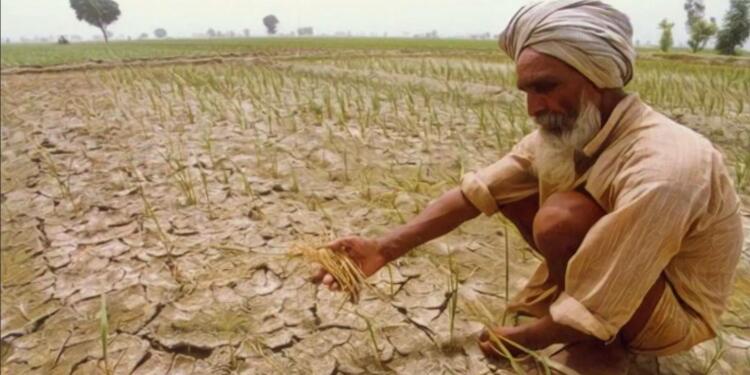During his election campaigns for Punjab elections, Arvind Kejriwal had promised that no farmer will commit suicide after his party comes to power. Just like other lofty promises of AAP Supremo, it also turned out to be a lie. The same story of farmer suicides is being repeated in states. While the rich farmers are enjoying the benefits of pro-farm schemes, real farmers continue to suffer.
Farmers’ suicides continue to hit the state
In Punjabi music, the main character’s attachment to his pind is a recurring theme. If you watch it closely, the character’s family is mostly engaged in farming. It makes up for a brilliant cocktail of modern North American guns being operated by an agricultural hardened hand. People love it, most probably you love it too, and millions of views on those songs are evidence of it.
But the reality is totally different. The very fact that the children of these farmers are running towards Canada tells you the grim reality of farming in Punjab. The state is in a deep agricultural crisis. Punjabi farmers are committing suicide at a rate unparalleled in the country. According to Bhartiya Kisan Union (Ugrahan), within 60 days after April 1, 55 farmers have killed themselves. According to a daily pioneer report, 14 of these 55 farmers had died in the first 25 days of April. Later when it was confirmed that wheat crops are not going to pick up momentum, 41 more farmers commit suicide.
Green revolution is the reason for debt crisis in Punjab
Loads of factors are behind this farmer suicide epidemic in Punjab. However, if one has to pinpoint one thing and then go into in-depth detail in order to solve the problem, then debt turns out to be the single factor. Farmers’ Debt is the fuel running both social and political engines in the state. The only thing it is not running is an average farmer’s life. Let’s decode the nitty and gritty of farmers debt issue in Punjab.
It may sound absurd, but the Green revolution is the main economic factor behind rising farmers’ debt in Punjab. During the Green revolution, Punjabi wheat and Paddy became the most demanded farm produce in India as well as around the world. As demand creates supply, almost the whole Punjabi farming community jumped on to the opportunity and started focussing on producing only these two crops. But, over a period of time, some other geographical entities developed their competence in both these crops as well. As a result, the demand for Punjabi wheat stagnated at a certain point.
Being not adaptive costs farmers a lot
However, Punjabi farmers refused to read the underlying signals and doubled down on their wheat and paddy produce. They were aggressively supported by politicians catering to the farmers’ vote bank. For the short-term political benefits, they kept encouraging them to sow more of these crops. Easier terms of loans and later loan waivers were also announced to keep farmers dependent on politicians. As a result, nearly 85 per cent of cultivated farm area in Punjab is dominated by these two crops only.
But, creating an alternate reality does not take away the existing one. The fact of the matter is that most of the farmers in Punjab are in severe debt. According to a 2017 study titled Indebtedness among Farmers and Agricultural Labourers in Rural Punjab, sponsored by the Indian Council of Social Science Research, New Delhi, an average farming family had ₹ 5.52 lakh debt on them. Astoundingly, 85.9 per cent of farm households were found to be under debt.
As a result, on average, nearly 1,107 farmers killed themselves every year between 2000-2015. 99 per cent of those farmers who killed themselves were small and marginal ones. The single reason these farmers could not meet their debt obligation was that the MSP was not effective in meeting their needs. Arahatiyas used to sell their produce and God only knows how much these farmers actually got the value of their produce. Debt numbers tell that original farmers get a meagre amount of that MSP. According to an estimate, total farm debt in Punjab is around ₹ 90,000 crore.
Protesting against Farm laws was the biggest blunder
So, it became imminent to provide free market access to these farmers. The Modi government did try to change it with the farm laws. It provided for big corporate intervention in the farm sector, making way for small farmers to increase their income. But politics by big farmers, AAP, Congress and other opposition parties did not let it succeed.
Farm laws were withdrawn and real farmers are again left in the hands of big farm lobby hobnobbing with local political units. Politicians again started to announce freebies. In December 2021, the Channi government announced that it would waive off loans up to ₹ 2 lakhs for small and marginal farmers. Similarly, AAP announced free electricity for water-guzzling crops.
Meanwhile, experts like Ashok Gulati are shouting over rooftops appealing to change the cropping pattern in Punjab, but to no avail. In the name of democracy, logic has died an illogical death in Punjab. Unfortunately, it is taking away farmers with itself.
Also Read: Kisanna Di Sarkaar: Bhagwant Mann issues arrest warrant against 2000 farmers in Punjab





























